JavaScript is partly an object-oriented language.
To learn JavaScript, we got to learn the object-oriented parts of JavaScript.
In this article, we’ll look at functions and objects.
Iterators
Iterators can be created with generator functions in JavaScript.
For instance, we can write:
function* genFn() {
yield 1;
yield 2;
yield 3;
}
We have a generator function as indicated by the function* keyword.
Then we can call it to return an iterator:
const gen = genFn();
console.log(gen.next());
console.log(gen.next());
console.log(gen.next());
We called genFn to get an iterator.
Then we called next on the returned iterator.
And the next method will return the object with the value and done properties.
value has the value from yield .
And done is a boolean to indicate whether all the values are returned.
IIFE vs Blocks
We don’t need IIFEs for containing variables in blocks anymore.
We can use let and const to declare block-scoped variables.
So if we have:
(function() {
var foo = 0;
}());
console.log(foo);
Then the console log will throw the ‘Uncaught ReferenceError: foo is not defined’ error.
We can do the same thing with let or const variables in blocks”
{
let foo = 1;
const bar = 2;
}
Arrow Functions
Arrow functions are great for creating callbacks.
#programming #technology #web-development #javascript #software-development
